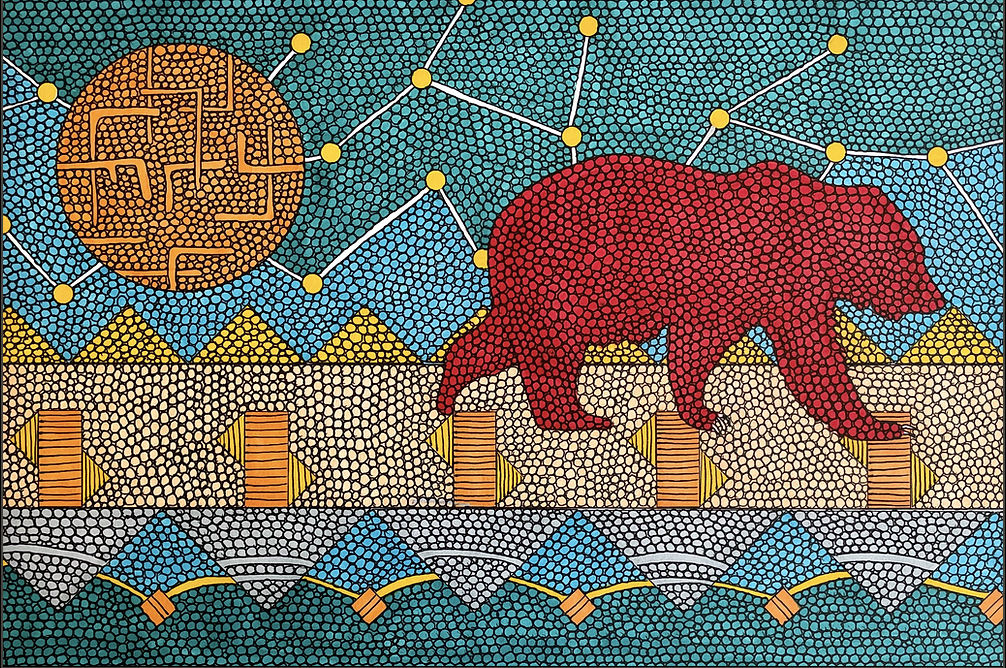Muscogee Nation art curator Laura Marshall Clark showcases the melding of cultures in her exhibition, Chief, Clans, & Kin.
Sons from Scotland, Ireland, Wales, and England set out for North America in the 18th century seeking asylum from political and religious oppression. Nearly 300,000 Scottish, Irish, and Welsh had arrived on the continent by the time of the American Revolution. Many found woodlands, fruitful soil, and rivers in homelands of the Chickasaw, Muscogee, Choctaw, Cherokee, and Seminole Nations of the Southeast. As Celtic immigrants began to marry into the tribes, they were influenced by everyday use of materials, language, textile styles, and some of their descendants became tribal leaders.
While exploring her own Muscogee Nation ancestry, art curator Laura Marshall Clark found among her kin a 1700s Irish tradesman who married two Muscogee women. She heard similar family stories among Five Tribes artists she knew. Inspired by their related backgrounds, she spent two years collecting work from them to develop the exhibition Chief, Clans, & Kin.
Through the new exhibition, artists of the Five Civilized Tribes with this mixed heritage bring their personal responses to this little-understood history. Both the distinction and the melding of Indigenous and Celtic paradigms are fused in deep connections of family histories held by these First Americans. The more than 60 artworks explore issue of singular and blended identities, cultural norms and anomalies, and shared histories of subjugation and colonization.
Above: Between Two Worlds; Bill Hensley (Chickasaw/Choctaw); 40 x 30 in.; Acrylic on canvas; Courtesy of artist.
The exhibition comprises works by 34 artists whose art reflects their Native American heritage and influences from across the pond. The exhibition opened first at the Living Arts Center of Tulsa; the show is now on view at the Choctaw Cultural Center, in Calera, Oklahoma, July 23 – December 31, 2022.
The artwork is diverse and varied; the artists well-known and emerging. The pieces, which range from pottery and beadwork to paintings and textiles, continue the ancestral traditions of color, Mississippian Period symbols, and traditional and nontraditional materials combined with modern techniques.
 Similarities in Line Quality, 2022, Daniel McCoy (Muscogee Creek); 16 x 20 in.; Mixed media on board; Courtesy of artist.
Similarities in Line Quality, 2022, Daniel McCoy (Muscogee Creek); 16 x 20 in.; Mixed media on board; Courtesy of artist.
Several of the artists credit their grandmothers as their inspiration. Chickasaw visual artist Dustin Mater describes how his grandmother helped him explore colors and the history of his tribe. Today in a style described as Muskogean rococo his works range from a portrait of an ancient Chickasaw clan mother to an oyster-shell carving depicting a tribal warrior sharing a ceremonial pipe with an Irish High King.
Sarah Sense, who is of Choctaw ancestry, remembers her grandmother’s story about the Choctaw Nation’s generous monetary gift in 1847 to the starving people of Ireland during the Great Potato Famine. Sense combines Choctaw and Celtic imagery in much of her work. She overlays photographs in a complex process with traditional basket-weaving patterns, creating striking two-dimensional art.
For Chickasaw and Choctaw textile artist Margaret Roach Wheeler, the inspiration extends even farther back in her family line: Her Mahota hand-wovens, named for her great-great-grandmother, are nods to both the Choctaw Nation and Scottish influences as evidenced by her piece Ishtaboli: Little Brother of War, a hand-woven cotton breechcloth in a Mahota tartan design that involved four weaving techniques.
Above: Deora De, 2020, J. Dylan Cavin (Choctaw), 21.5 x 15 in.; Ink, watercolor; Courtesy of artist.
Artists Erin Shaw, Bobby Martin, and Tony Tiger blend symbols of their tribal and Celtic ancestries in painting, ceramics, and prints. Contemporary artist Billy Hensley creates Indigenous portraits of past and present tribal members, while Daniel McCoy uses vibrant colors and images from pop culture, landscapes, and his Indigenous traditions.
Cherokee artist Martha Berry’s bead art incorporates motifs of the Five Tribes; Scott Roberts’ glorious pots are hand built and fired in the style of ancient Muscogee and Choctaw artisans. Bladesmiths Daniel Worcester and his son J. Daniel produce art on the forge, creating stunning inlaid knives sought by collectors. Chiefs, Clans & Kin also includes Chickasaw bead artist Shelby Rowe’s fascinating portraits.
 Bear Crossing, 2021, Billy Hensley (Chickasaw/Choctaw); 16 x 22 in.; Ink and watercolor on paper; Courtesy of artist.
Bear Crossing, 2021, Billy Hensley (Chickasaw/Choctaw); 16 x 22 in.; Ink and watercolor on paper; Courtesy of artist.
Whether in sculpture, painting, textile art, finger weaving, pottery, block prints, metal work, photography, or works on antique ledger paper, artists of the Five Civilized Tribes featured in this unique exhibition depict their contemporary culture in works of enduring beauty.
“Indigenous and Celtic identities rest in not only the importance of family and the communities we care deeply about, but in values centered on relationship, respect, cultural continuance, and honoring ancestors,” Clark says. “The artworks in Chief, Clans, & Kin bring us together, make connections across time, uphold our distinct and vibrant cultures, and forge a shared path.”
From our August/September 2022 Issue
Lead art (at top of page): Blue Moving, 2020, Brenda Kingery (Chickasaw/Choctaw); 23 x 30 in.; acrylic on paper; courtesy of artist
Chief, Clans & Kin is on view July 23 – December 31, 2022 at the Choctaw Cultural Center in Calera, Oklahoma. For more information, visit choctawculturalcenter.com.






















